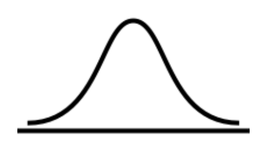Norming
Norming Options
Normed measures such as those found in Receptiviti's Big 5 Personality, Needs and Values, DISC, and Fast and Slow Thinking frameworks produce scores that are baselined against large datasets. These norming datasets contextualize the scores so they are reflective of the language patterns that are typical within a particular context or for a specific language data source. The norming process results in scores that fall along a standard normal curve, as shown below:

When scoring data with the Receptiviti API, it is important to make the right choice about what dataset to use for norming in order to produce accurate insights. There are three options:
1. Receptiviti's Written Norming Dataset:
The data that you score will be compared against written language from a wide variety of contexts, ranging from social media to emails to news articles to novels. This dataset would be applicable for use with social media posts, web copy, product reviews, and other data sources that involve written language.
2. Receptiviti's Spoken Norming Dataset:
The data that you score will be compared against transcribed language from a wide variety of contexts, ranging from interviews to group calls to speeches to earnings calls. This dataset would be applicable for use with executive speeches, transcripts of focus group interviews, and other data sources that involve spoken language.
3. A Custom Norming Dataset:
With custom norming, the scores for each data point are compared only against the data that you have provided for custom norming, making it reflective of your use case and data sources. This simplifies score interpretation, as the distribution usually allows for a clear distinction between higher and lower scores.
When using Receptiviti's norming datasets, note that the average of scores within your data may be systematically high or low on different measures due to differences in the way that people speak or write in the particular context or platform where your data was collected. This can be informative in some cases, or may simply be a pattern you need to remain aware of. Custom norming makes the score distributions more predictable and easier to interpret.
Detailed information on using custom norming features, including when and why to apply them, is available here.
deciding whether or not to use the custom norming feature